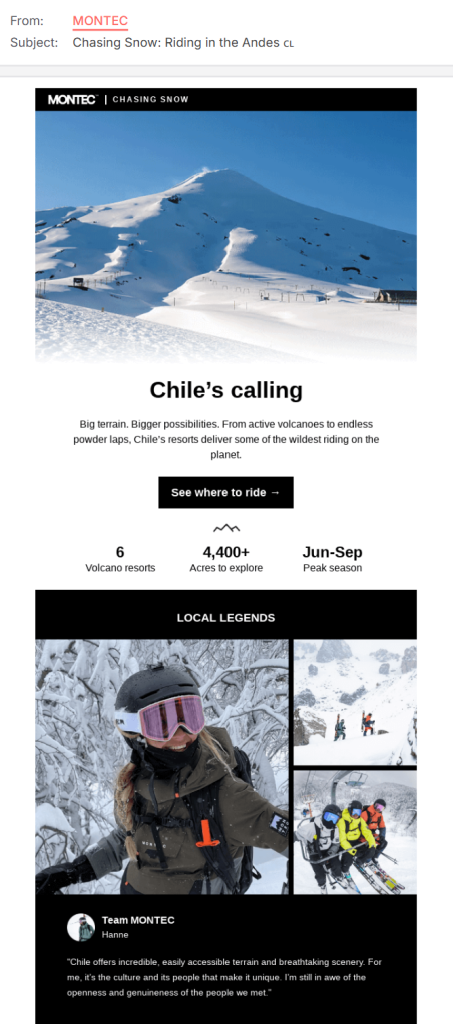- Home
- Email Tips and Tricks
- 30+ Travel Email Subject Lines ...

✨ Key takeaways:
⭐ A compelling subject line can turn a quick look at an email into real travel intent.
⭐ Seasonal timing amplifies relevance by aligning emails with readers’ current moods and desires.
⭐ Psychological triggers like urgency, curiosity, and aspiration are most effective when matched to the audience mindset.
⭐ Personalization in travel subject lines builds trust and resonance that generic lines lack.
⭐ Strong subject lines work best when supported by segmentation and cohesive design.
⭐ Testing different approaches ensures subject lines are aligned with shifting traveler behavior.
You’ve probably already heard how important subject lines for an email campaign are, because they’re literally the first impression you make on your readers—and you’ve likely read plenty of reminders about that. Yet in this article, we want to revisit this well-known fact with a sharper focus: travel email subject lines. For travel brands, subject lines matter even more than they do in other industries.
The reason is simple: travel decisions are different. Buying a pair of shoes or signing up for a SaaS tool can be quick, repeatable, even routine. Booking a trip is not. It’s rarer, more emotional, and often comes with higher stakes—money, time off work, family plans, even identity (What kind of traveler am I?). On top of that, in the travel industry there are plenty of service providers: airlines, hotel chains, Booking.com and Airbnb, and countless online agencies.
Because of this, a travel email can’t afford to be generic, while subject lines have to be inspiring or curiosity-driven to a point a user wants to open the email right away. It’s a higher bar, but also a greater opportunity: the right subject line can turn casual curiosity into an actual booking.
Travel Email Subject Line Ideas by Season & Occasion
📌 Why seasonal subject lines work better, especially in travel email marketing
Travelling is one of those activities that almost always depends on the season. While in July people mostly crave beaches and rooftop bars, December invites thoughts of skiing (or, again, beaches for many). So, it only makes sense that email subject lines reflect this mood seasonality and place a reader inside a moment they’re already living. That sense of timeliness is what makes it feel personal, almost as if the email anticipated their daydreams.
There’s also something about the fleeting nature of seasons that fuels urgency. Summer feels short, winter holidays vanish in a blink, and spring always carries the promise of a fresh start. Your email subject line shall acknowledge this rhythm to remind readers that opportunities to travel won’t last forever. If you manage to catch this sentiment in your subject line, you’ll remind people that they need to act while the season is still here. That blend of relevance and emotion is why seasonal subject lines consistently outperform generic ones in travel email marketing.
🌞 Summer travel subject lines
Summer is the season that feels like it is full of possibilities. People are more spontaneous, often ready to book a trip just because the sun feels good and the world feels open. That’s why summer email subject lines work best when they’re simple and full of promise at the same time. Like this:
- “Your Summer Escape Is Just One Click Away”
- “Pack Light, Travel Far—Summer Deals Inside”
- “Lazy Beaches or Busy Cities? Find Your Summer Vibe”
- “Sun. Sand. Savings. Ready?”
- “Make This Summer One to Remember 🌴”
❄️ Winter travel subject lines
Winter brings a different kind of yearning. Some want to escape the cold, while others prefer to embrace it by chasing snowy peaks or festive city streets. Winter email subject lines should tap into both moods: the cozy and the adventurous.
- “Trade Frost for Palm Trees This Winter”
- “Winter Getaways That Feel Like a Hug”
- “Powder Snow. Hot Cocoa. Perfect Winter Trips Await”
- “Escape the Chill—Warm Destinations Inside”
- “Your Winter Wonderland Is Calling”
🎄 Holiday & festive travel subject lines
Holidays carry their own emotions—traditional and personal at the same time. For travel brands, festive subject lines can invite people to make the season more memorable, not just at home but also away.
- “Celebrate the Holidays Somewhere New”
- “Festive Flights: Where Will You Ring in the New Year?”
- “Your Holiday Getaway Awaits—Book Before It’s Gone”
- “More Than Gifts: Give a Journey This Year”
- “Deck the Halls—or Skip Them for the Beach 🌊”
⏱ Last-minute vacation subject lines
Last-minute trips are driven by impulse—and often by a little urgency. In this case, a subject line for a vacation email should feel like a nudge: “Go now, or miss out.”
- “Still Thinking? These Last-Minute Deals Won’t Wait”
- “Pack Tonight, Be There Tomorrow ✈️”
- “Spontaneous? Perfect. Here’s Your Escape”
- “Weekend Getaway: Flights Leaving Soon”
- “Your Last-Minute Paradise Is One Click Away”
Travel Email Subject Lines by Tone & Psychology
📌 How to choose the right tone and psychological trigger?
The power of subject lines lies in how they interact with human decision-making. A useful lens here is Daniel Kahneman’s dual-process theory of thinking, which divides the mind into two distinct systems: System 1 (fast, emotional, instinctive) and System 2 (slow, rational, deliberate). In our inboxes with lots and lots of emails, most choices are made by System 1—quick, intuitive reactions rather than careful reasoning.
This is why tone matters. An urgent subject line can spark fear of missing out before logic intervenes. A curious phrasing opens a mental loop that people feel compelled to close. Aspirational lines pull on emotions and identity, while practical lines create instant clarity and ease. The underlying science is the same: by speaking to the fast, emotional side of the brain, travel email subject lines stand a far greater chance of being opened. Choosing the right trigger is about matching the tone to the mindset of your audience in that moment.
Urgency & scarcity
Urgency works because people are naturally loss-averse. A subject line that signals limited time or availability activates the fear of missing out, pushing readers to act before they think too much.
- “Last 2 Seats to Bali—Grab Them Now”
- “Summer Escapes End at Midnight—Book Today”
- “Winter Deals Vanish After Friday—Don’t Miss Out”
- “Your Beach Getaway Is Slipping Away Fast”
- “Final Call for Paris Weekends Under $200”
Curiosity & surprise
Curiosity is a powerful motivator, rooted in the information gap—when people sense they’re missing knowledge, they feel compelled to fill the gap. In subject lines, this works best when paired with intrigue and travel discovery.
- “Guess Where Flights Are Cheaper than Coffee”
- “The One City Everyone’s Booking This Winter”
- “A Secret Island You’ve Probably Never Heard Of”
- “What Destination Just Topped Booking.com Searches?”
- “You Won’t Believe Where $99 Can Take You”
Aspirational & inspirational
Aspirational subject lines work because travel isn’t just logistics—it’s also identity and emotion. They remind readers of who they want to be and what kind of memories they want to create.
- “Your Dream Escape Is Waiting Just for You”
- “Because Memories Last Longer than Things”
- “Where Will Your Next Story Begin?”
- “Turn Your Weekend Into a Lifelong Memory”
- “Travel Isn’t a Plan, It’s a Feeling—Find Yours Here”
Practical & helpful
Practical tones appeal to the brain’s craving for clarity and ease. Inboxes are full, so a subject line that feels useful, structured, and solution-oriented always stands out.
- “Top 5 Family-Friendly Vacations Under $500”
- “Direct Flights That Save You Both Time and Stress”
- “Affordable Airbnb Picks for a Quick Weekend”
- “Budget-Smart City Breaks with Daily Itineraries”
- “How to Plan the Perfect Last-Minute Trip with Kids”
Personalization in Travel Agency Email Subject Lines
Personalization is one of the strongest levers in email marketing, even more so in travel email marketing. Subject lines play a crucial role in the personalization of travel messages.
When a message includes a name, a recently searched destination, or even a reminder of an unfinished booking, it signals to a particular person that their choices mattered. Instead of feeling like another mass promotion, it feels directed—something created for you. For travel agencies, this is particularly powerful because vacations are personal decisions by nature: where you go, when you go, and why you go are all tied to individual preferences.
Here are a few examples of how personalization can work:
- “Emma, Still Dreaming of Rome?”
- “Your Paris Weekend Deal Is Waiting, Alex”
- “Ready to Finish Booking Your Bali Escape?”
- “Flights to New York Dropped Since Your Last Search”
- “Anna, Your Favorite Beach Is Calling Again”
Why does this outperform generic phrasing? Because relevance drives attention. Numerous studies in email marketing have shown that people are more likely to engage with content that acknowledges their past behaviors or personal details. By including some personal details, you turn an email into a continuation of the traveler’s own thoughts, which is exactly why personalized subject lines consistently achieve higher open rates than their generic counterparts.
Three Travel Email Subject Lines You Can Learn From
When it comes to travel email marketing, sometimes seeing is better. Let’s look at some examples from real-life brands to see how you can personalize your travel offers for different seasons, occasions, and audiences.
Email subject line for snow sport lovers—personalized by destination

Email subject line that feels so relatable to each and every one of us

Email subject line personalized for exclusivity

Best Practices for Crafting Travel Email Subject Lines
Subject lines may be short, but they should never be simple. A few best practices can help ensure your travel email subject lines have all that is needed to convert your readers’ curiosity into bookings.
- Keep it personal and relevant. For example, if you run email marketing for a travel blog, your subject lines should do more than announce a new post. Tie them directly to the reader’s wanderlust—hint at destinations, tips, or stories that are relevant to this particular person (to know how, read the next point).
- Segment your travel email campaigns. Not every subscriber dreams of the same trip. Families, solo travelers, and luxury seekers respond to very different hooks. Segmenting your lists ensures your subject lines speak directly to what matters most to each group.
- Match subject lines with design. The promise made in your subject line should flow naturally into the look and feel of the email itself. Well-structured travel newsletter HTML templates help deliver on the subject line’s promise without you breaking a sweat.
- Balance creativity with clarity. Quirky or poetic lines can stand out, but never at the cost of being unclear. A subject line must spark interest while signaling that the email is about travel.
- Test and refine. Even the best-crafted subject lines can surprise you in performance. A/B testing different tones, lengths, and keywords helps you learn what truly works for your audience.
To Sum Up
A subject line isn’t just a line. It’s the first touchpoint of your email on your readers’ devices. It’s the gateway to a mood, a memory, a moment. Especially in travel, where decisions are often emotional and personal, that gateway really matters. It has to pull the reader in like gravity. Your reader should have no other choice but to really crave their next vacation.
That’s what separates high-performing vacation email subject lines from forgettable ones: they create a lasting impact. So, craft your email subject lines in a way that makes the reader feel like they’ve already booked the trip and now just need to click to make it real. With the tips from this article, your next subject lines will hopefully do the trick!



